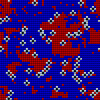Why are lipid rafts not observed in vivo?
- PMID: 17660324
- PMCID: PMC2025652
- DOI: 10.1529/biophysj.106.101931
Why are lipid rafts not observed in vivo?
Abstract
The existence of lipid rafts in live cells remains a topic of lively debate. Although large, micrometer-sized rafts are readily observed in artificial membranes, attempts to observe analogous domains in live cells place an upper limit of approximately 5 nm on their size. We suggest that integral membrane proteins attached to the cytoskeleton act as obstacles that limit the size of lipid domains. Computer simulations of a binary lipid mixture show that the presence of protein obstacles at only 5-10% by area dramatically reduces the tendency of the lipids to phase separate. These calculations emphasize the importance of spatial heterogeneity in cell membranes, which limits the transferability of conclusions drawn from artificial membranes to live cells.
Figures







Similar articles
-
The influence of membrane bound proteins on phase separation and coarsening in cell membranes.Phys Chem Chem Phys. 2012 Nov 14;14(42):14509-15. doi: 10.1039/c2cp41274h. Epub 2012 Jul 17. Phys Chem Chem Phys. 2012. PMID: 22801988 Review.
-
Domain formation in the plasma membrane: roles of nonequilibrium lipid transport and membrane proteins.Phys Rev Lett. 2008 May 2;100(17):178102. doi: 10.1103/PhysRevLett.100.178102. Epub 2008 Apr 28. Phys Rev Lett. 2008. PMID: 18518341
-
Influence of nonequilibrium lipid transport, membrane compartmentalization, and membrane proteins on the lateral organization of the plasma membrane.Phys Rev E Stat Nonlin Soft Matter Phys. 2010 Jan;81(1 Pt 1):011908. doi: 10.1103/PhysRevE.81.011908. Epub 2010 Jan 14. Phys Rev E Stat Nonlin Soft Matter Phys. 2010. PMID: 20365400
-
Effect of integral proteins in the phase stability of a lipid bilayer: application to raft formation in cell membranes.J Chem Phys. 2010 Apr 7;132(13):135104. doi: 10.1063/1.3381179. J Chem Phys. 2010. PMID: 20387961
-
Detecting microdomains in intact cell membranes.Annu Rev Phys Chem. 2005;56:309-36. doi: 10.1146/annurev.physchem.56.092503.141211. Annu Rev Phys Chem. 2005. PMID: 15796703 Review.
Cited by
-
Interleaflet Coupling of Lipid Nanodomains - Insights From in vitro Systems.Front Cell Dev Biol. 2020 Apr 28;8:284. doi: 10.3389/fcell.2020.00284. eCollection 2020. Front Cell Dev Biol. 2020. PMID: 32411705 Free PMC article. Review.
-
Breaking up isn't so hard to do.Biophys J. 2007 Nov 1;93(9):2984-5. doi: 10.1529/biophysj.107.115618. Epub 2007 Jul 27. Biophys J. 2007. PMID: 17660323 Free PMC article. No abstract available.
-
Detection of lipid domains in model and cell membranes by fluorescence lifetime imaging microscopy of fluorescent lipid analogues.J Biol Chem. 2008 Nov 7;283(45):30828-37. doi: 10.1074/jbc.M801418200. Epub 2008 Aug 15. J Biol Chem. 2008. PMID: 18708353 Free PMC article.
-
Structural determinants and functional consequences of protein affinity for membrane rafts.Nat Commun. 2017 Oct 31;8(1):1219. doi: 10.1038/s41467-017-01328-3. Nat Commun. 2017. PMID: 29089556 Free PMC article.
-
Diffusion as a probe of peptide-induced membrane domain formation.Biochemistry. 2011 Mar 29;50(12):2291-7. doi: 10.1021/bi102068j. Epub 2011 Mar 4. Biochemistry. 2011. PMID: 21332237 Free PMC article.
References
-
- London, E. 2005. How principles of domain formation in model membranes may explain ambiguities concerning lipid raft formation in cells. Biochim. Biophys. Acta. 1746:203–220. - PubMed
-
- Lagerholm, B. C., G. E. Weinreb, K. Jacobson, and N. L. Thompson. 2005. Detecting microdomains in intact cell membranes. Annu. Rev. Phys. Chem. 56:309–336. - PubMed
-
- Silvius, J. 2005. Lipid microdomains in model and biological membranes: how strong are the connections? Q. Rev. Biophys. 38:373–383. - PubMed
-
- Carrasco, M., M. J. Amorim, and P. Digard. 2004. Lipid raft-dependent targeting of the influenza A virus nucleoprotein to the apical plasma membrane. Traffic. 5:979–992. - PubMed
Publication types
MeSH terms
Substances
Grants and funding
LinkOut - more resources
Full Text Sources

